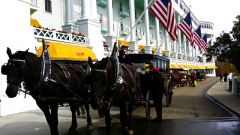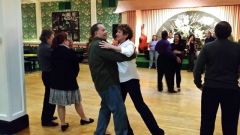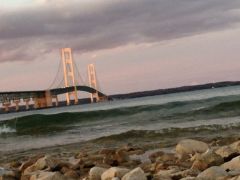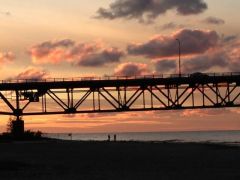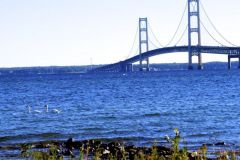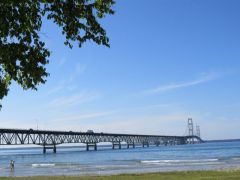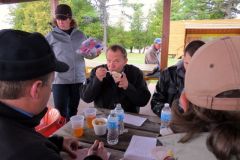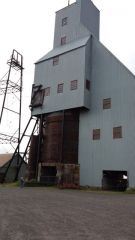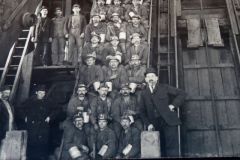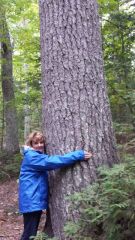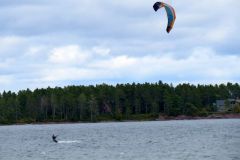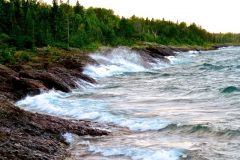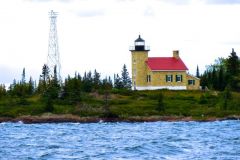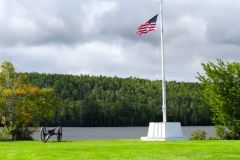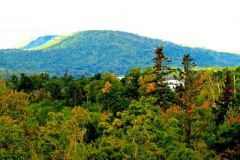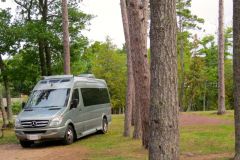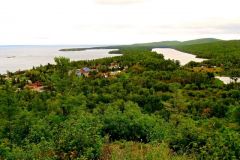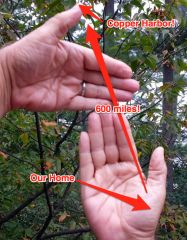-
Content Count
669 -
Joined
-
Last visited
-
Days Won
17
Content Type
Profiles
Forums
Blogs
Gallery
Everything posted by Roadtrekingmike
-
From the album: Dancing the Weekend Away on Mackinac Island: Where your RV C
No cars (or RVs) on the island. You walk, ride a bike or get carted by horse. -
From the album: Dancing the Weekend Away on Mackinac Island: Where your RV C
Here we are, all dressed up. -
From the album: Dancing the Weekend Away on Mackinac Island: Where your RV C
Learning the Tango. Jennifer was excited about three 1 1/2 hour instructional classes that were offered Saturday morning and afternoon. That’s 4 1/2 hours! Then she expected me to get dressed up and dance the night away! -
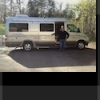
Dancing the Weekend Away on Mackinac Island: Where your RV Can’t Go
Roadtrekingmike posted a blog entry in Roadtreking Blog
RVers aren’t the only ones winding down the season this time of year. So is Mackinac Island, the summer resort island located in the Straits of Mackinac at the tip of the Michigan mitt, right where Lake Michigan meets Lake Huron. Next weekend, the place shuts down until spring, with only a single hotel, restaurant and bar left open to serve the several hundred full-time residents and the workmen who come in during the winter to renovate, repair and restore the hotels and shops. Many shops were shutting down this weekend. Jennifer and I have made it a tradition to visit this special island every year at this time. Gone are the thousands of summertime tourists who jam the streets and make it difficult to navigate on foot. The stores all have deep discounts and there’s a sort of back-to-nature feel for the place as winter approaches. In fact, snow is in the forecast here for mid next week. There are no motorized vehicles on the island. You walk, ride a bike or get carted around by a horse. So our Roadtrek was left back across the straits on the mainland, in the parking lot of the ferry boat company that makes the 20-minute crossing a dozen plus times a day. The boats will start cutting back trips next week and, usually by the end of December or early January, have to suspend all service because of ice. Most winters, the only way to the island in the winter is by air or, for the adventurous, by snowmobiles over the ice bridge that forms between the island and St. Ignace, the closest city in Michigan’s Upper Peninsula. Locals mark the path by sticking Christmas trees along the route and entrepreneurial St. Ignace business owners have been known to set up portable bars and hot dog stand on the ice half way between. So this week is the last active week here before most everything closes down until late April. At the massive Grand Hotel, where we are staying, the largely Jamaican staff, many of whom have served here season after season, will be leaving a week from Monday. Frederick, one of our waiters at breakfast, is in his 26th year at the Grand. This weekend, the hotel is featuring a ballroom dancing extravaganza that has brought people in from across the country. Decades ago, we spent a couple of years taking ballroom dance lessons. We like to joke that disco dancing saved our marriage. This weekend saw me not being able to remember a single step. There were beginning and intermediate classes during the day. Friday and Saturday nights, everyone dressed up and danced to a full orchestra, complete with a vocalist. Some of the men wore tuxedos. One guy wore a Scottish kilt. Several wore spats. The women wore fancy shoes and elaborate dresses that ranged from formal to Dancing With the Stars-like costumes, complete with hats and long gloves. The Grand bills itself as “America’s Summer Place” and has been welcoming guests since 1867. Today, like back then, you still must dress for dinner. No jeans, shorts or casual clothing is allowed after 6 p.m. Whenever we come here, we bring our bikes across on the ferry and try to ride around once or twice each day. It’s 8.4 miles around, all on a paved road along the shoreline that offers great views of the water. We also enjoy riding the interior roads, past natural attractions and the marvelously restored fort on a high bluff above town that was built buy the British during the American Revolution and later became the scene of two strategic battles in the War of 1812. At night, we walk. Friday night, the temperature was a crisp 38 degrees and there was a beautiful full moon peeking out between the clouds. We strolled the west bluff overlooking the twinkling lights of the Mackinac Bridge that connects Michigan’s two peninsulas. On our right were gigantic Victorian mansions that are summer homes built by turn-of-the-last-century business tycoons. Then we made our way back to the Grand to watch the dancers twirl around the dance floor. Saturday, it was dancing all day and night. Our first class, the Tango, began at 9 a.m.. Then came the Rumba. Then East Coast Swing. At night, everyone danced. Non-stop. The Fox Trot, the Waltz, the Quick Step, Cha-Cha, Rumba, Jitterbug, Swing and variations of them all. The dancing crowd had a surprising number of young couples, despite the Big Band music from the 1940s. Jennifer is immensely enjoying the island, the dancing, the old world charm of the Grand. I love having a happy wife. But two nights of wearing a suit and tie are enough to last me a long time. I’m greatly anticipating being reunited with the Roadtrek tomorrow and finding a place in the woods to boondock before heading home Monday. Finally…for those of you who asked … here’s video of us dancing during our swing class. No snickers, please: -

RV Boondocking and Elk Watching in the Pigeon River State Forest
Roadtrekingmike posted a blog entry in Roadtreking Blog
Now this is boondocking. We drove 11 miles off the Interstate, down a forest road lined by brilliant yellows and red birches and oaks. Then we turned off that and went a mile and a half off down a washboard two-track, pulling into a state forest campground on a little circular lake aptly named Round Lake. We haven’t seen another car in miles. Its pouring rain. The heater is keeping out the 44-degree weather and we are toasty comfy in our Roadtrek eTrek, watching Game 4 of the American League Playoffs, rooting for our Tigers in the middle of nowhere. I had no bars on my MiFi data card or my Samsung Note 3 smartphone. But when I put the data card in my Wilson Seek cell phone booster with its external antenna magnetically attached to the top of the Roadtrek, I suddenly have four bars of pure Verizon 4G connectivity. In the middle of nowhere. TV. The Internet. Lights and heat. Water. Food, Ciffeee. Our own shower and bathroom. The comforting sound of rain drumming on the roof. This is why we Roadtrek. This is why we boondock. This is heaven, albeit a little wet. The Pigeon River Country State Forest and surrounding land where we are camped is home to the largest free-roaming elk herd east of the Mississippi River. The nearly 100,000-acre state forest contains native hardwoods and pines that are interspersed with fields and forest openings. It looks like the color up here peaked last week. But its still jaw-dropping gorgeous. The nice thing about boondocking is you can sleep with the blinds up. The morning came with the rain gone, the sun spotlighting the color across the fog shrouded lake. What a way to wake up. I suspect there’s another week or so of color left before they leaves start dropping fast. Elk inhabit this forest year-round, but certain times are better for viewing than others. Probably the best month is September, when the males (bulls) are trying to establish dominance for mating rights with the females (cows). They are very active during this time, making loud vocalizations (bugling), and breaking brush with their antlers to impress cows and intimidate their rivals. But even now, a month past the rut, they’re still pretty perky. I awoke Friday morning to the sound of them bugling, their high pitched, nasally noises echoing through the piney woods around our campsite from somewhere towards the east ... The elk or wapiti is a large member of the deer family. Adult males may weigh up to 1/2 ton. Want to visit this place? Come up I-75 to Exit 290 at Vanderbilt, then drive east on Sturgeon Valley Road about 11 miles to the forest trail leading to Round Lake. There are a couple of pit toilets and an old fashioned hand water pump. But no amenities. We’ve been here before. In the summer, you might find one or two other campers here. But during the week and off season, chances are you’ll be have the whole place to yourself. If you want to visit one of the several designated elk viewing sites, continue east about three miles to Hardwood Lake Road. Turn left (north) and continue about one mile to the Forestry Field Office. This office has maps and information about elk viewing, but hours are variable depending on the season. The view outside our window of Round Lake in the Pigeon River State Forest unrise with the last of the fog being burned away from Round Lake in the Pigeon River State Forest A bull elk can weigh half a ton The girls… a herd of cow elk in the Pigeon River State Forest -
The temperature outside my Roadtrek in the driveway of our Michigan home was 34 degrees this morning. That’s the coldest yet this season and a reminder that soon, there will be no putting off the fact that it needs to be winterized. We still have a couple of long weekend trips planned and I am hoping that I can do them without pushing antifreeze down all the pipes. It’s funny, really, because even when the RV is winterized, there’s no reason I can’t use it. You just carry drinking water and use antifreeze to flush the toilet. No big deal. But still, winterizing means winter and winter means cold and, well, the fact of the matter is this has been such a great season for our RV that I hate to see it end. November and December are the times we use it the least. It won’t be long till the first of the snowbirds head south. These are usually Class A owners and they tend to sit in one spot all season long. We’re not like that with our Class B. And since we tend to move around a lot, it’s hard to get reservations n Florida. Impossible, really. So I don’t think we’ll even try Florida this year. Instead, we’re looking at a trip after the New Year, over towards the Texas Hill Country and the southwest. But this relatively inactive time after the first hard freeze settles in until the holidays are over always leaves me a little sad. I hate to see a good thing end… even if it’s temporary. Guess the best cure for the off season blues is to plan the next season. How about you? What are your plans for the next couple of months?
-

Crossing the Mackinac Bridge in an RV
Roadtrekingmike added images to a gallery album in Members Gallery
-
From the album: Crossing the Mackinac Bridge in an RV
You can walk right under the bridge at Fort Michilimackinac State Park in Mackinaw City. -
From the album: Crossing the Mackinac Bridge in an RV
Counting the approaches, the Mackinac Bridge is five miles long. This is from Fort Michilimackinac State Park in Mackinaw City. -
From the album: Crossing the Mackinac Bridge in an RV
Sunset, looking west from Fort Michilimackinac State Park in Mackinaw City. -
From the album: Crossing the Mackinac Bridge in an RV
From Straits State Park in St. Ignace, looking south. This was from our campsite there. -
From the album: Crossing the Mackinac Bridge in an RV
The view from Mackinaw City of the Mackinac Bridge. And yes, the two names are spelled differently. Pronounced exactly the same but spelled differently. I have no idea why. -
Spanning the two Michigan peninsulas is the Mackinac Bridge, the longest suspension bridge in the western hemisphere. It is always a highlight of our trips to the Upper Peninsula. When you say “Big Mac” to a Michigander, the bridge is what they think of, not the hamburger. Counting the approaches, the bridge is five miles long. What makes it so interesting is the very nature of its construction. A suspension bridge is designed to move to accommodate wind. And high above the Straits of Mackinac, where Lake Michigan merges with Lake Huron at the very tip of the Michigan mitt, there is always wind. In fact, according to the Mackinac Bridge Authority, the state agency that runs the bridge, it is possible that the deck at center span could move as much as 35 feet (east or west) due to high winds. Seriously. This would only happen under severe wind conditions, mind you. And the deck would not swing or “sway” but rather move slowly in one direction based on the force and direction of the wind. After the wind subsides, the weight of the vehicles crossing would slowly move it back into center position. Sometimes, the bridge is shut down. Electronic signs along I-75 so alert drivers and a low power radio station continuously broadcasts bridge conditions. Large trucks usually require an escort. But RVs usually have no problems. I say usually. I’ve crossed the bridge in our Roadtrek a dozen times. On a couple of occasions, I was aware of some pretty stiff cross winds. Nothing that caused any serious apprehension, but enough to keep my speed down. Occasionally, there have been vehicles rolled over on the bridge because of high winds. In 1989 a woman driving a two-year-old Yugo inexplicably stopped her super light weight vehicle on the bridge over the open steel grating on the bridge’s span. A gust of wind through the grating blew her vehicle off the bridge. That’s the only death not attributed to accidents or suicides. The most recent suicide was late last year, by someone who jumped over the rail. In 1997 a man in a Ford Bronco intentionally drove off. But such incidents are very rare. Yet, because of the nature of suspension bridges, there’s always an element of adventure in crossing the Big Mac. The view is always spectacular. I put together this little video during our most recent crossing. It was late on a cloudy day on mid-September. Some 200 feet below it, ferry boats could be seen making their way back and forth to nearby Mackinac Island from Mackinaw City, the last town in the Lower Peninsula and St. Ignace, the first town in the UP. Before the bridge was opened in 1957, automobile ferries made the crossing. Every Labor Day, people can walk across the bridge. I’ve participated in a couple of bicycle rides that also cross the bridge as well. But the bridge is only open for vehicular traffic except on a very few special occasions during the year. So driving is how most of us cross. If you haven’t driven across the Big Mac bridge, put it on your bucket list. If you want to spend the night and check out the bridge, the best place to do so is on the UP side, at Straits State Park in St. Ignace. There are spots right along the lake shore with magnificent views. If you just want to get close and take some photos or maybe have a picnic, the Fort Michilimackinac State Park on the Mackinaw City side has lots of RV parking with great bridge views.
-

Albuquerque Balloon Launch Draws Class B RV Owners
Roadtrekingmike posted a blog entry in Roadtreking Blog
When blog reader Harry Salt sent me these spectacular photos (see below), I just knew I had to share them. They are from the annual Albuquerque International Balloon Fiesta, now under way in New Mexico. Harry was part of two RV groups that attended – a Class B group and a Roadtrek group. “The festival goes thru Oct 13,” writes Salt. “After Oct 7 some of the group went on a ’walkabout’ for about 30 days. Supposed to have been at National Parks and Monuments but now they are improvising. It will end Early November at the 49er Death Valley Encampment.” Attendees were from Massachusetts to Alaska and Harry says there were 58 Roadtreks, one Krystal, one Chateau. Eleven were Sprinter brands. He tried to get them all in the photos but would have needed a much wider lens. What makes the skies so blue and Salt’s photos so spectacular is why the event is held this time of the year. This is the 42nd time that the Balloon Fiesta has filled Albuquerque’s crystal blue skies. The Balloon Fiesta is still the premier international ballooning event, powered by the perfect October climate and a phenomenon called the “Albuquerque Box,” (a combination of weather patterns and geographic landscape, the box allows balloonists to control and even retrace their adventure). It’s held at Balloon Fiesta Park. The 200 acres of grass and booths are filled with balloons and vendors selling everything from traditional New Mexican food to balloon memorabilia. Each year balloon teams from around the world participate in the event and news coverage originates from more than 50 countries. It has become the most photographed event in the world. You may have missed the first weekend but this event really goes on every day. The breathtaking mass ascensions featuring waves of hot air balloons will fill Albuquerque’s morning skies this coming weekend, too. I gotts do this smoeday. You, too? Thanks Harry, for sending the photos. -
The active RV season in the north is on limited time as the cold weather approaches, but before many of the RVs are put to bed or in storage, many RV parks around the country are hosting special Halloween get-togethers and site decorating contests. And the parks are filling up. At the Addison Oaks County park near our Michigan home, where we walk our dog several times a week, the Halloween weekend turns into quite a spectacle, with contests, trick-or-treating and prizes for the best-decorated RV. They call it the Boo bash and once it ends, the park shuts down for the season. RV Halloween weekends are being held all over this year as the concept has spread across the county. I know of no park, though, that is into the spirit of it all like the Lake Rudolph Campground & RV Resort in Santa Claus, Ind., which is planning seven – count them, seven – consecutive Halloween-themed activities this fall. “It’s the most popular thing we do,” said Dave Lovell, the resort’s director of marketing. The park hires professional story tellers for Friday night bonfires. There are haunted hayrides, costume contests, scary movies and a dance-until-you-drop sound and light show. As an indicator of how popular it is, reservations start rolling in a year in advance. The last event this year is Oct. 25-26. The 2014 Halloween weekend schedule is already up on their website. The Lake Rudolph folks are not alone. Most Jellystone Parks around the country now offer Halloween themed activities, while more than a third of KOA’s nearly 500 campgrounds offer Halloween themed activities and so do many privately owned campgrounds. If groups and lots of fun and activities are your thing and especially if you have young kids or grandkids, you might one to try one of these Halloween gatherings. The Lake Rudolph RV Resort in Santa Claus, Ind., hires professional storytellers to tell ghost stories around a bonfire. These sites might be of interest to you: Yogi Bear's Jellystone Parks - Halloween weekends Go Camping America - fall and pre-Halloween activities Kentucky State Parks - Halloween events
-

Apps and Websites to Help You Find the Perfect Boondocking Spot
Roadtrekingmike posted a blog entry in Roadtreking Blog
Ah ... the Sound of Silence. There really is a sound to it, you know. On a boondocking trip deep in the Michigan woods in Ogemaw County, we heard it good. There was the crackle of our campfire. A hoot of a distant owl. The yips of a pack of coyotes somewhere far to the west. The gurgle of the Rifle River moving over a stretch of rocks just downstream from where we were camped. The whooshing sound of wind whipping through a stand of pine. And on that clear night, the sound of boondocking silence comes with a view. Up above, as soon as you walked away from the fire and got your night eyes focused, a gazillion stars speckled the ink black sky. That’s the first big perk of boondocking, or being totally self-contained with no commercial power or water or sewer or any other service. Some people prefer to call it “dry camping” or “independent camping.” Other terms are “primitive camping” or “dispersed camping.” Whatever, we were loving it. No one else was around. Probably for miles. Tai, our Norwegian Elkhoud, ran free, though not very far from our motorhome. I swear he smiled the whole weekend, blissfully exhausted from leash-free hikes and the new scents of deer trails and the deep woods. We slept with the blinds up and the windows open with complete privacy. In our all electric Roadtrek eTrek, with solar power and a diesel heater connected to the engine, we can go that way for days. In fact, the limiting factor for us out there is how much food we can bring. More often than not, we need to resupply about every three days. Because we have eight house batteries, 250 watts of solar power, a diesel generator that charges the batteries on a half hour or so by just running the engine, a refrigerator, heater, microwave/convection oven, air conditioner and inductive stove that are powered by a 5,000-watt inverter, our eTrek is made for boondocking like that. But most all Class B motorhomes can boondock, some for a night or so, others a couple days. But where? I use the Internet and apps to help me find new places to boondock. For starters, check out the app for iPhone, iPad and Android devices by AllStays (www.allstays.com). They list more than 22,000 commercial campgrounds, state and national parks and boondocking spots, everything from KOAs and Walmarts to state and federal forests, military and BLM land. This is my favorite app and website, offering the most detailed information of any app I’ve yet found on places to stay. There are other resources. Free Campgrounds for RVs (http://www.freecampgrounds.com) has a big database, sorted by state, of state, federal and county land open to camping, most without hookups or services. For boondocking and camping information about National Forests, check out the very useful U.S. National Forest Campground Guide (http://www.forestcamping.com). Much of the research was done by Fred and Suzi Dow, a couple of avid RVers who have spent the last 17 years visiting 155 national forests, 20 national grasslands, 1 national tallgrass prairie and 2,383 developed campgrounds. I also like the Free Campsites website (http://freecampsites.net). There’s an interactive map as well as comments and reviews of boondocking spots. You can also check the site http://boondocking.org. It’s a database of free boondocking spots based on GPS coordinates. Enter in your location’s latitude and longitude and it will tell you whether the closest boondocking spot may be. Those are some of my favorite boondocking resources. How about you? Share your suggestions under comments. Boondocking in our eTrek the middle of the Michigan woods in Ogemaw County. -

RV Vacations Ruined as National Parks Shut Down
Roadtrekingmike posted a blog entry in Roadtreking Blog
The budgeting mess and political wrangling in Congress over Obamacare has ruined the vacation plans of tens of thousands of RVers who had planned to camp in a national park this week. The closure of the national parks is also hitting hard the bordering communities whose economic livelihood is closely tied to a steady stream of national park visitors. At midnight, all activities at the parks, except for necessary emergency services, were immediately suspended and the parks closed indefinitely. In addition camping on all Bureau of Land Management land has been halted and the National Parks Service had furloughed 21,000 employees of its nearly 24,675-strong workforce. Essential services such as law enforcement will continue, but all public recreational use has been shut down. Visitors currently camping or staying in a national park have been ordered to leave by Friday and all roads leading to the parks are being closed to public access. New visitors showing up will be turned away. On Monday, the Department of Interior, which runs the parks service, released details on the closures, which effects all 401 national park areas including such popular destinations as Yellowstone, Grand Teton, Yosemite, Glacier, Acadia, the Great Smoky Mountains and the Rocky Mountain National Park. RVers, who tend to be older without young children, find the parks particularly attractive to visit at this time of year because, with school in session across the country, the summer crowds are diminished and its easier to move about the parks. This isn’t the first time there have been shutdowns because of Congressional funding disputes. In the Clinton administration, the parks shut down for 28 days in late 1995 According to the Congressional Research Service, the the shutdowns cost the country $1.4 billion. And there was massive public outrage. “Once the shutdowns began, the reaction from people who wanted access to the parks was absolutely incredible,” Bruce Babbitt, who was U.S. Interior Secretary at the time, said in an interview Monday with environmental reporter Paul Rogers of the San Jose Mercury News. Here are some excerpts from Rogers’s story: “The first call I got was from the governor of Wyoming, who was having a fit. He was saying ‘You have to open Yellowstone. This is an outrage. Do something!’” The then-governor of Arizona, Fife Symington, sent National Guard troops to the Grand Canyon in an attempt to keep the park open, rather than risk losing tourism. Eventually, Arizona officials paid the National Park Service through state funds and donations to keep famous sites along the South Rim open. “It’s especially hard to turn away families who have planned vacations, and people have nonrefundable plane tickets,” said B.J. Griffin, who was Yosemite National Park superintendent in 1995. “For some people, this is their once-in-a-lifetime visit. Back in 1995, the anger and the anxiety was properly placed. Visitors knew it was Congress and not our rangers.” How long this shutdown will last is unsure. Hopefully, this one will be shorter than the one n 1995. Here is the official statement from the Department of the Interior: “Effective immediately upon a lapse in appropriations, the National Park Service will take all necessary steps to close and secure national park facilities and grounds in order to suspend all activities except for those that are essential to respond to emergencies involving the safety of human life or the protection of property. Day use visitors will be instructed to leave the park immediately as part of Phase 1 closures. Visitors utilizing overnight concession accommodations and campgrounds will be notified to make alternate arrangements and depart the park as part of Phase 2. Wherever possible, park roads will be closed and access will be denied. National and regional offices and support centers will be closed and secured, except where they are needed to support excepted personnel. These steps will be enacted as quickly as possible while still ensuring visitor and employee safety as well as the integrity of park resources.” So that’s the latest. Again, let’s hope this doesn’t last long and those who were planing national park vacations can find suitable alternative places to camp. I don’t want to get political here on Roadtreking. The country is already polarized beyond anything I have ever seen in my 30 plus years as a journalist. Ad we have Roadtreking.com readers who hold very different views on the issues surrounding the shutdown. So if you comment below, please don’t bash anyone or engage in political wrangling. Let’s stick to what we all agree on: It’s a shame our national parks are closed. And if you have suggestions for those out there looking for places to stay, by all means share it here. -

Copper Harbor, Mich. -- the End of the Road
Roadtrekingmike added images to a gallery album in Members Gallery
-
From the album: Copper Harbor, Mich. -- the End of the Road
I was a judge in the annual chili cookoff. -
From the album: Copper Harbor, Mich. -- the End of the Road
The Quincy Mine offers tours. -
From the album: Copper Harbor, Mich. -- the End of the Road
This historic photo shows how men went a mile underground to mine copper. There were deaths every week. -
From the album: Copper Harbor, Mich. -- the End of the Road
Some of the Estivant white pines are 400 years old, 150 feet high and 8 feet around. -
From the album: Copper Harbor, Mich. -- the End of the Road
Just outside town is Estivant Pines, a 500-acre stretch of virgin white pines. -
From the album: Copper Harbor, Mich. -- the End of the Road
The always-on winds from Lake Superior make for good kite surfing. -
From the album: Copper Harbor, Mich. -- the End of the Road
The area is a mountain bike mecca and the Brickside Brewery is their hangout.


